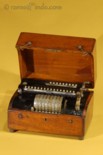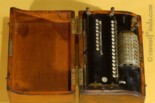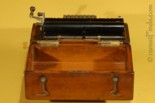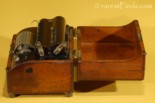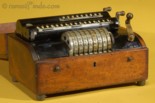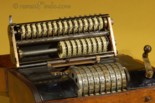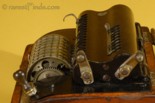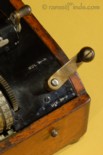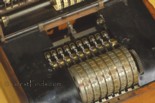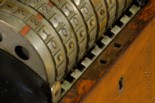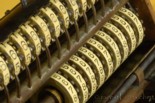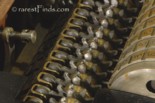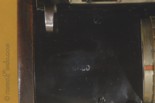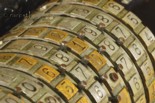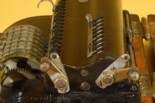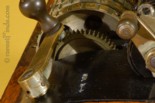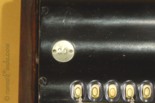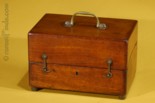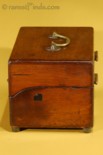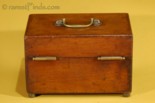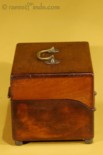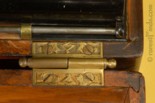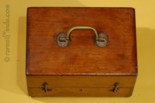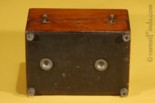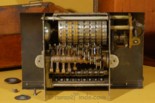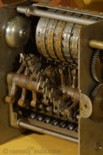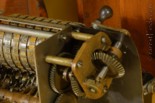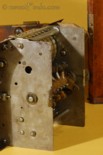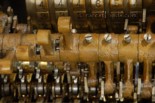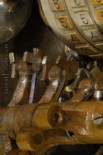One of only three known extant Frank S. Baldwin Calculators Patented in 1902. Sold!
Patents, click on any image to see larger image!








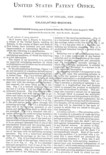
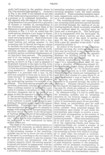
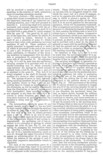
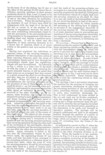
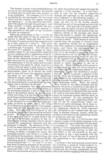
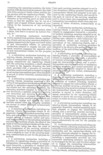
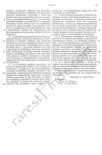
History:
Frank S. Baldwin is for many reasons the most important American inventor of calculators the 19th century has to offer. Inspired by Charles Xavier Thomas de Colmar's Arithmometer of 1820 — which was an improvement over Leipniz's stepptwheel design of around 1672 — Baldwin replaced the steppedwheels with a pinwheel that had nine spring loaded pins around the edge of its wheel. Thomas' design needed a steppedwheel for each digit of the operant number; Baldwin's improved design only needed one wheel for all digits of the operant number.
According to the patent document, Baldwin applied for the patent to protect his invention on September 8, 1873. His application was only granted almost one and a half years later on February 2, 1875. The patent has the number
159,244, and the title, "IMPROVEMENT IN CALCULATING-MACHINES." As I will show further down, Baldwin filed a caveat for his invention as early as October 5, 1872.
This invention by Baldwin marked the beginning of the calculating machine industry in the United States. Frank S. Baldwin (1838-1925) not only replaced the Leibniz steppedwheel with a pinwheel, Baldwin's machine also eliminated the reversing gears previously needed to switch from addition to subtraction. This was another significant advance.
Shortly after Baldwin saw for the first time a Thomas Arithmometer in 1870, he hired William Seward Burroughs, who worked in a machine shop together with his father, to build Baldwin's calculator. William S. Burroughs undoubtedly was inspired by Baldwin's calculator and eventually went on to invent his own calculator and became one of the three largest manufacturers in the field:
About 1870 he [Baldwin] saw the first stepped drum machine and it caught his interest. He decided to build a machine with only one cylinder instead of nine drums. The resulting model may be found in the patent office in Washington (figure 41). In order to build this model, he employed William Seward Burroughs, later to be the designer of the adding machine capable of printing the result and which bears his name. It is known that Burroughs did not start working on his own machine until 1880. See [1], page 72.Baldwin built ten of these machines including the patent model, which he called on his application for patent no. 159,244, "Improvement in Calculating-Machines." One of the nine machines and the patent model are in the collection of the National Museum of American History. The patent model is a printing version of his invention with 3 dial operant input or setting mechanism, 4 digit revolution counter or proof register, and 7 dial result registering mechanism (3 x 4 x 7 setup), the nine other models had a 8 x 8 x 17 digit setup and did not have printing capabilities.
While still waiting to have his first patent granted, Baldwin devised a much simpler machine to add one digit at a time he called Arithmometer. Baldwin applied for a patent for his Arithmometer on April 1, 1874. This patent, the second patent for which Baldwin filed a patent application for a calculating device or machine, was granted on July 28, 1874, with the title, "IMPROVEMENT IN ADDING-MACHINES," and the patent number 153,522, was assigned.
Machines based on his first and second patent failed to reach any production numbers for different reasons. Some museums built copies of his first machine, the machine based on his pinwheel, to have an exhibit to show. Please note, his application for his second patent was granted first.
Only five of his Arithmometers are known to exist. One of the five extant machines is actually offered for sale on rarestfinds.com, click here to see the listing!
Some sources falsely attribute Baldwin's improvement of the Thomas design with his invention of the pinwheel to Willgodt T. Odhner with the justification that Baldwin's machine was not a financial success. The record however is clear; Baldwin applied for his patent for the pinwheel design on September 8, 1873, while Odhner built his first calculator only the following year:
Since Odhner's efforts date back only to 1874, the year he made his first model, it seems now definitely proven that Baldwin was the first to employ, in practice, the gear with the variable number of teeth in a calculating machine. It may be assumed that Odhner reinvented this device at a later date. See [1], page 71. See also [3] page 427.One of the foremost experts on early calculating devises, L. Leland Locke, provides an in-depth analysis of the question who the inventor of the pinwheel is, and how Odhner was able to get his very similar machine patented in 1878, patent no. [209'416,] while Baldwin's patent was still active.
His analysis is not only convincing, it unequivocally yields the name Baldwin as the inventor of the pinwheel. See [3] page 428.
Also, consider this: Communications by telegraphy across the Atlantic was possible since July 27, 1866, and by February 2, 1875 - the date Baldwin's patent was issued - duplex and quadruplex transmissions made telegraphy affordable even for private individuals.
Odhner was wealthy and well connected to the U.S. Even so Odhner only built 14 of his first design at the Ludwig Nobel factory in 1877, two of the 14 machines were sold to US government officials! The machine with serial number 4 was purchased by Professor Ezekial Brown Elliot, United States Actuary. The owner of the other machine with serial number 9 was Joseph S. McCoy, another actuary of the US government.
It seems that the actuaries of the U.S. Treasury were the perfect testing ground and launching pad for early calculators. Another inventor, Michael Bouchet, left one of his column adders known as "Bouchet Adder" he patented in 1882 and 1885 with Joseph S. McCoy, actuary of the U.S. Treasury. Bouchet never return to pick up his machine he left in McCoy's office in 1890. There is also a description with picture in [2], page 41.
While Baldwin according to his own account sold some of his Arithmometers, his initial machine with the pinwheel was never produced. Baldwin himself built only the patent model and nine machines in a little shop he rented in Williamsport Pennsylvania.
In 1900 Baldwin was granted a patent for a calculator which is totally different from his other designs. Instead of his pinwheel, Baldwin used platens with protruding teeth, 0 through 9, over which a carriage traveled to operate the machine digit by digit. I assume that this machine was never manufactured as neither the patent no. 641,065, nor the machine is known. Furthermore, the patent papers show the remark "(No Model.)" I could not find any place on any website which even mentions this patent other than the Official Gazette by the Patent Office, Vol. 107, No.6, issue of December 8, 1903, page 1,383, where I found it.
The Calculator offered here:
In 1902, Baldwin, "went back to first principles in this machine [machine of 1902], employing the reverse action in dividing and subtracting, the carrying motion being provided on a separate shaft, reducing the diameter of the main cylinder to one half the size of that of the 1875 machine." See Baldwin's interview further down.
The 1902 machine offered here is Baldwin's first production machine which was capable of all four operations, additions, subtractions, multiplications, and divisions. The machine is still in its original mahogany case with its lid. The lid can be removed easily by sliding it to the left to separate it from the case. The machine is fastened with two screws to the case. These two screws are shown in picture 24.
With only one shop selling the machine in the entire country, this machine still did not bring Baldwin the well deserved success. Only three machines are known to have survived. The one offered here is the only one in private hands. The other two machines are in the National Museum of American History,
(machine with serial number 50
without the wooden lid, and
machine with serial number 150
with the wooden lid or cover).
According to the National Museum of American History website, the calculator with the serial number 50 is a gift of the Monroe Calculating Machine Company; the machine with serial number 150 is one of the machines of the collection donated by
L. Leland Locke.
Since all three machines have serial numbers in the teens and hundreds (20, 50, and 150), there is a propensity that serial numbers issued or assigned to machines were, 10, 20, 30, 40 ect, and not 1, 2, 3, 4, 5, 6, 7, 8, 9, 10, 11, ect. This could have been a scheme to insinuate larger production numbers than the actual numbers. This would also explain the reason for only three extant machines.
Not only did L. Leland Lock donate his collection of early calculators and adding machines, we are also indebted to Locke for a document which proves that Baldwin, as early as October 5, 1872, had invented the pinwheel:
Baldwin was the first to employ this device [the pinwheel] in practice. We are indebted to L. Leland Locke, a well-known American calculating machine expert, for the photograph of a document according to which Frank Stephen Baldwin and William E. Harvey swore on 28 September 1872, before a notary public in St. Louis, that they believed to the best of their knowledge and conscience to be jointly the first inventors of the ‘improved calculating machine according to the following specification.’ The specification is a patent application received at the patent office in Washington on 5 October 1872, which contains exact details and drawings of Baldwin’s machine, specifically of the model that appeared on the market in 1875 that included the gear with the variable number of teeth. On the 8th of September 1873, an improvement on the first model was added to the patent. See [1] page 71.
Frank S. Baldwin was a prolific inventor and the inventor of the pinwheel; Baldwin's first application for his pinwheel calculator on October 5, 1872, predates Odhner's patent by two years.
Willgodt T. Odhner's calculator used slides to enter numbers; Baldwin's 1872 patent used slides too. But only after changing his design to a key-entry it became hugely successful under the brand name MONROE.
The other big name, William Seward BURROUGHS, had exposure to Baldwin's ideas when Baldwin hired him around 1870.
BURROUGHS, FELT & TARRANT, and MONROE (Baldwin), were the big U.S. manufacturers of calculators in the twentieth century; and Frank S. Baldwin undoubtedly was the most important and influential inventor in the field.
Complete list of Patents issued to Baldwin for Calculating Devices:
Here the patents relating to calculating devices, click on any link to download the patent; keep in mind that every typed character, number, word, or sentence, in bold and italic on this website is a link!
The list below is the most comprehensive and complete list of calculator and adding machine patents issued to Baldwin you will find on the internet or anywhere else; here they are listed in order of application dates:
Patent no. 159,244, applied for September 8, 1873; granted February 2, 1875, title, "IMPROVEMENT IN CALCULATING MACHINES." An image of this machine is shown in Figure 41, page 72 in [1]. There is also a description with picture in [2], page 82. The patent model and also one of the nine machines Baldwin built are in the National Museum of American History.
Patent no. 153,522, applied for April 1, 1874; granted July 28, 1874, title, "ADDING MACHINES." An image of this machine is shown in Figure 40, page 72 in [1]. To see the Arithmometer offered for sale here on rarestfinds.com click here!
Patent no. 641,065, applied for August 3, 1899; granted January 9. 1900, title, "CALCULATING MACHINE."
Patent no. 706,375, applied for November 26, 1901; granted August 5, 1902, title, "CALCULATING MACHINE." This is the patent the machine offered here for sale is based on. An image of this machine is also shown in Figure 48, page 75 in [1].
Patent no. 745,991, applied for August 8, 1902; granted December 8, 1903, title, "COMPUTING AND RECORDING MACHINE." Baldwin made two different versions of this machine; one without a printer, and one with a printer, (again, click on the bold-italic typed words and you will see the corresponding machine!). An image of this machine without a printer is also shown in Figure 47, page 74 in [1]. The machine with the printer in the National Museum of American History is also one of the machines of the collection donated to the museum by L. Leland Locke.
Patent no. 890,888, applied for January 24, 1907; granted June 16, 1908, title, "CALCULATING AND RECORDING MACHINE."
Patent no. 1,080,245, applied for June 15, 1912; granted December 2, 1913, title, "CALCULATING MACHINE."
Reissued patent no. 13,841, applied for, April 20, 1914; reissued December 8, 1914, title, "CALCULATING MACHINE."
Reissued patent no. 13,842, applied for, April 20, 1914; reissued, December 8, 1914, title, "CALCULATING MACHINE."
Patent no. 1,207,700, applied for, February 24, 1915; granted December 16, 1916, tile, "CALCULATING MACHINE."
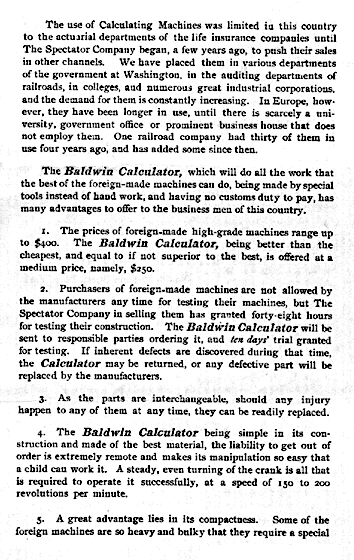
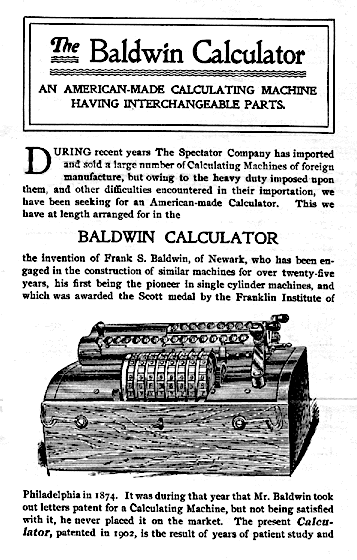
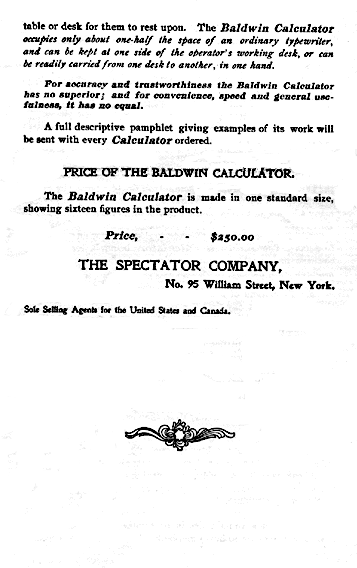
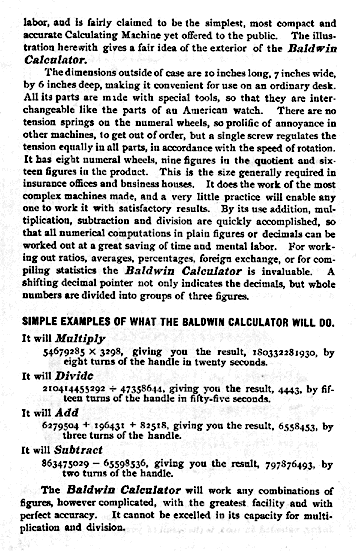 THE SPECTATOR COMPANY, No. 95 William Street, New York, NY, was the sole Selling Agents for the United States and Canada.
See four page booklet on the right (c. 1903).
THE SPECTATOR COMPANY, No. 95 William Street, New York, NY, was the sole Selling Agents for the United States and Canada.
See four page booklet on the right (c. 1903).
The machine had "interchangeable parts," a manufacturing technique that was not a guarantee at the time. The technique was introduced during the civil war when rifles had to be repaired on the battle field.
The calculator was sold for $250.00 and was capable of 200 turns a minute. That is more than three turns per second! $250.00 is the equivalent of $8,750 in today's money!
Condition:
Some of the parts in the pictures look like they are rusty or corroded. All these parts are actually made of brass but the patina has the color like rusted iron. I did check all these parts with a magnet to be sure.
The machine is (almost) all complete and I can not see any repairs or defects at all. The only thing I noticed missing is one decorative little ball of the hing of the case on the right, see picture 20.
Both registers of the carriage can easily be set to zero. Everything turns but with resistance because of the dirt and dried up organic oil. Some of the pins are stuck on digit one and five from the right, and these wheels do not turn. I did not force anything and I also did not attempt to clean it. The black tin cover over the mechanism has been re-painted black at one point in time as by careful inspection with the right lighting, the old paint-lines can be seen. The machine is in "as found" condition.
I would recommend washing the mechanism with Carbon Tetrachloride under the necessary precautionary measures to protect from the highly toxic fumes, or, the less toxic Tetrachlorethylene.
The wooden case has a small full Mortise cabinet lock but the key is missing. Only one of the other two known machines also has this recessed lock, the calculator with the serial number 50. The other calculator with serial number 150 has an outside mounted chest lock which is less laborious to install; this change was probably made in an effort to save cost in the manufacturing process.
This machine clearly was used as the hand-crank's nickel-plating is worn off in places. The four rubber feet at the base were replaced at some time.
Frank S. Baldwin Interview of 1919:
Here is a comprehensive interview of Frank Baldwin from 1919, in which he describes the main moments of his life, [for clarification, I added patent numbers in square brackets to Baldwin's recollection of his different inventions of calculators and adding machines]:
In the summer of 1840, when I was two years old, my family moved to Nunda, Livingston County, New York.Frank Baldwin died on 8 April 1925, following an operation in a private hospital in Morristown, New Jersey. Hi passed just two days short of his 87th birthday. Until the last day of his life, his mind was clear and keen, and his interest in his family and the things about him was just as pronounced as ever.
At Nunda, I attended the first free school instituted by the State of New York. Afterwards, I was graduated from the Nunda Institute, where I had specialized in mathematics. In a class competition, I surprised my teachers by memorizing the decimal of Pi to 128 places, and ever since that time I have been able to write it without effort.
In 1854 I was enrolled at Union College. My course was short-lived, for soon after my entrance, father met with a serious accident, which crippled him for life and forced me to take over the management of his architectural business. I then began experimental work on several ideas.
In 1855, I applied for a patent on an arrowhead self-coupler for railroad cars. It was rejected on reference. This rejection only fired my ambition to succeed and perhaps determined my later course in the field of invention.
In 1860, business took me to Fort Wayne, Indiana. An uncle at Carlyle, Illinois, had designed a corn-planter for which I assisted in securing a patent. This was a pioneer of machines of this class. Early in ‘61, I went over to Carlyle to build the first model and arrange for the manufacture of the device.The Civil War broke out and upset my plans. I enlisted in the Carlyle Home Guard, but stress of circumstances brought me back to Fort Wayne after the Three Months. So the war fever in me had to burn itself out in looking after the family.
In 1869, I went to St. Louis as manager of Peck’s Planning Mills. It was at this point I began to devote more and more time toward working out the ideas I had in mind. There was one in particular from which I now derive a great deal of satisfaction, because it is being used on such a universal scale. It is the metal lace latch seen on so many shoes. It came into being as an aid to my own quick dressing.
About this time, I invented an instrument called the Anemometer, for recording the direction of the wind; also a registering step for street cars, recording the number of passengers carried; and a street indicator geared from the axle showing each street in succession, from an illuminated box, as the car passed. These I placed in successful operation. This ended my efforts to improve the railroad business.
Frank Stephen Baldwin in 1870:
Shortly thereafter, I invented and patented the “Recording Lumber Measure”, a machine which automatically measured and recorded four different kinds of lumber at the same time. This device set me thinking about computing machines and this point really marks the birth of the Monroe.
In the office of a life insurance company at St. Louis, I had seen the Thomas type of calculating machine, devised by C. X. Thomas of Colmar, France, about 1820. I contrived the plan of substituting one cylinder for the nine cylinders in that machine, making a working model, which is now in the Patent Office at Washington. [159,244.]
It was on this model that William Seward Burroughs, later of Burroughs Adding Machine fame, did some work for me in a small general machine shop, which he, with his father, had in St Louis.
Not until about 1880 did Mr. Burroughs start work on his own adding machine with a keyboard set-up. The meteoric success of the business that bears the Burroughs name is history.
In October 1872, I married Mary K. Denniston of Williamsport, Pennsylvania, who was visiting relatives in St. Louis. The year after, we moved to Philadelphia where I rented a small shop and started to make ten of the calculating machines. [159,244]. While thus engaged, I saw the expediency of a small machine to supplement the larger one, and designed an adding machinewhich I named the “Arithmometer”, and this patent, dated July 28, 1874, was the first one of the kind granted me by the United States Patent Office [Baldwin still waited for the earlier filed patent no. [ 159,244], to issue]. It was also one of the first adding machines sold in the United States.
I placed both machines on exhibition at the Franklin Institute, Philadelphia, and was awarded the John Scott Medal for the most meritorious invention of the year. The only other inventor that year receiving a similar honor from the Institute was George Westinghouse for his air-brake. The Government granted me patent rights in 1875.
As soon as one of the calculating machines was finished [159,244], I took it to the office of the Pennsylvania Railroad and was referred to Mr. George M. Taylor, Auditor of Freight Receipts. As soon as he saw the machine, he exclaimed, “You are a year too late. If I could have had a machine like that a year ago, it would have been invaluable. I have had a series of tables prepared, giving rates on quantities from 1 to 2,000 pounds, carried from 1 to 550 miles of the road, making over a million computations. Seven different clerks have checked each sheet and I have just had them lithographed for distribution to the agents. However, I would like to see your machine tested.”
He asked a clerk to bring in one of the sheets. Then he began calling off the items while I multiplied them on the machine. After about fifty items he cried, “Hold on, that is wrong.” I looked at the sheet and there surely was a discrepancy. To make certain, I erased it and did it over. I said, “The error is in the sheet, sir”. “What, you dont mean to say that the table is wrong?” “Prove it for yourself, sir,” said I. Had a bomb been exploded in the office, the consternation could not have been greater.
The clerks were hastily called in and each one had to figure it himself before he would believe those tables could be wrong. “Well,” said Mr. Taylor, “I will buy your machine if you will instruct one of my clerks how to operate it, and then I want all of these tables gone over and proven correct.”
I taught one of them how to use it and he began the work of checking, which took some time, but three months later he confessed to me under the pledge of absolute secrecy that he had found 135 errors in the tables, seven on one sheet. The lapse of time is my only excuse for breaking that pledge.
I still have a copy of Mr. Taylor’s letter written to me from Philadelphia on August 8, 1874.
F.S. Baldwin, Esq.
Dear Sir: I have used for the last four months one of your large machines [159,244,] daily in this department and have no hesitation in saying it performs its work rapidly and reliably, and for the purpose used does the work of at least three men with a certainty of correctness and greater rapidity. For Railroad Companies, calculating mileages and tonnages, it is, I consider, invaluable. Yours respectfully,
G.M. Taylor,
P.R.R.Co.
Of course I was elated at this proof of the utility of the machine and plunged into the business with renewed vigor, but I soon found that I had undertaken too heavy a task. So I made a contract with the Reliance Machine Works of Philadelphia to manufacture the machines, while I took charge of the Sales Department. I met with considerable success in selling the adding machines [153,522], but found the town too slow to accept the calculators [159,244], so I concluded to try New York. There I sold several calculators to the leading life insurance companies and one to the State Department in Albany.
Although pleased with my success in New York, I was anxious to secure the endorsement of the Government, so I resolved to strike at the fountainhead at Washington.
I went to the office of the Secretary of the Treasury. After waiting until the crowd was thinned out, I walked boldly into his office and placing the machine on his desk, said: “Mr. Secretary, I wish to call your attention to a machine which I believe will prove very useful to the Government.” I proceeded to demonstrate it. Secretary Benjamin Bristow looked at me quizzically for a moment and then pushed a button on his desk. An elderly gentleman appeared, whom I found afterwards to fill the position of Actuary of the Department. “Mr. Elliott, said the Secretary, this young man has a very interesting machine here which I wish you to examine thoroughly and send me a report upon.” Mr. Elliott bowed and, beckoning me to follow, led me to his own office, which I frequently visited afterward. I found him not only a fine mathematician, but a most agreeable companion and very popular in the Departments, and it was through his assistance that I was able to place the remaining calculators with the Government.
One afternoon he took me out to the National Observatory and introduced me to the celebrated scientist, Professor Simon Newcomb, saying: I want to present Mr. Baldwin, who writes and recites Pi to 128 places. Professor Newcomb was very much interested in the calculator and complimented me highly.
All this time I was holding demonstrations in the evening at the hotel or in private houses with the machine, as most people had never heard of such a thing as “metal brains,” and some, thinking I had manipulated certain figures, would insist on giving me problems of their own, often in their haste making a mistake and having to retire in confusion.
One evening a young man introduced himself as the Private Secretary of General Benjamin F. Butler and insisted that I should show it to the General as he was deeply interested in mechanics. I spent two hours with the General going over the machine. When I had finished, he turned to me and said: “Well, young man, you have made a most remarkable machine, but I tell you, you are thirty years in advance of the Age.” Rather cold comfort that, but my experience since has convinced me that he was about right. Although I had been successful in placing the ten calculating machines [see [3] page 427], they had been made principally by hand, affording no profits. As the Reliance Machine Works did not have the facilities for quantity production, and the failure of Jay Cooke, with the ensuing panic, caused such a stagnation in business, I gave up the fight and returned to St. Louis in 1876, where, after a while, I started to work up gradually.
It was about this time that one of my 1875 models [159'244] found its way to Europe, falling into the hands of a Mr. Odhner, a Swede. He took out patents in all European countries on a machine that did not vary in any important particular from mine, and several large manufacturing companies in Europe took it up. It is now appearing under ten to fifteen names in Europe, the more important being Brunsviga and Triumphator, manufactured in Germany.
In 1900, I patented the Baldwin Computing Engine, a machine by which multiplication or division was performed by one stroke for each digit.[Interestingly, the machine he patented in 1900, pat. no. 641,065, he called "CALCULATING MACHINE;" the patent with the title, "COMPUTING AND RECORDING MACHINE." was issued in 1903, pat. no. 641,065. The machine he called "COMPUTING AND RECORDING MACHINE" was not capable of performing multiplication and division. It is likely that he misspoke and intended to refer to the machine with patent no. 641,065. Was Baldwin confused at the time he gave this interview?]
In 1902, I brought out the Baldwin Calculator [706,375]. I went back to first principles in this machine, employing the reverse action in dividing and subtracting, the carrying motion being provided on a separate shaft, reducing the diameter of the main cylinder to one half the size of that of the 1875 machine [159,244]. Some of these machines are still in use, after more than a quarter century of service.
In 1905, I designed a listing machine with only ten keys and a spacer [745,991].
In 1908, I was awarded a patent on the Baldwin Recording Calculator, which combined the listing machine with the calculator. [890,888]. This machine, with the keyboard and oscillating bars, formed the germ of the present Monroe.
Jay Randolph Monroe in 1919:
In 1911, I became acquainted with Mr. Jay R. Monroe, then associated with the Western Electric Company in New York City. Only a few years prior he had been graduated from law at Michigan. He was a young man then, and is still young in years, but mature in ideas and judgment.
Mr. Monroe had always been of a mechanical turn of mind, but fortunately his work, following his graduation, was along clerical and commercial lines. This brought him in close touch with calculating machines and the various uses to which they were being applied, and he began to study them for their weaknesses, endeavoring to devise ways in which they could be improved. It was about this time that he told me that the day had arrived when business was demanding a more efficient machine than had then appeared on the market- one that anyone could operate after one explanation; one that was portable; one that was simple in construction; one that furnished perfect visibility with a proof of accuracy; one with a keyboard set-up; one that would not only add, but multiply, divide and subtract as easily as it could add. I showed him my machine. At once he saw its possibilities. We joined hands and set about designing the machine to make it as nearly perfect as possible in its adaptation to the needs of modern business. The result of that work and our later association is the Monroe High Speed Adding-Calculator which is filling no small part in faithful, economic service in the realm of business. [890,888; 1,080,245; reissued patent no. 13,841; reissued patent no. 13,842; 1,207,700.]
Literature:
(Click on any title to see the online version of the book or publication if there is one.)
[1]
The Calculating Machines (Die Rechenmaschinen), Their History and Development, by Ernst Martin, translated and edited by Peggy Aldrich Kidwell and Michael R. Williams, (1992), pp. 71-75.
[2]
Origin of Modern Calculating Machines, by J.A.V. Turck, Chicago, 1921, The Western Society of Engineers.
[3]
The History of Modern Calculating Machines, An American Contribution, L. Lealand Locke, The American Mathematical Monthly, Vol. 31, No. 9, pp. 422-429 (November 1924).
[4]
Die Rechenmaschinen und ihre Entwicklungsgeschichte 1. Band; by Ernst Martin, pp. 15, 45, 75, 120, and 265. Published by Hans Burghagen Verlag, Hamburg(1925).
Inventory Number 09350;
Sold!
